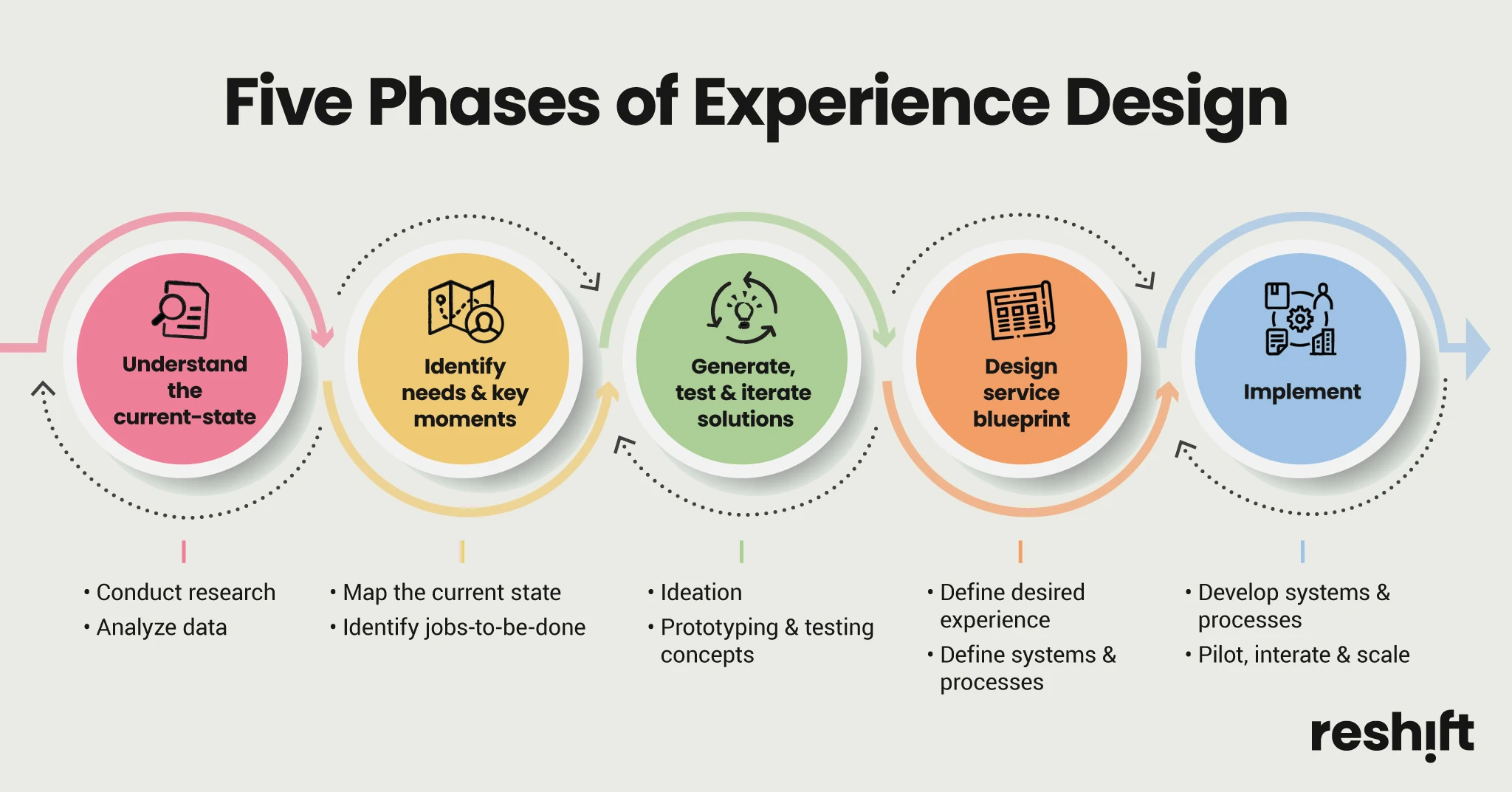Written by Steve Bosak and Marc Bolick
Good customer and employee experiences do not happen by chance. They result from organizations that truly care for their people and their customers as part of their culture. Think of the culture as the fertile ground for good experience delivery, but it is not adequate alone. Whether you seek to improve customer satisfaction and loyalty, or ensure you attract and retain the best talent, experience design is a proven way for organizations to take control of the interactions that people have with their brand.
There are bottom-line impacts from poor customer experience. According to a PwC study1, 32% of all customers would stop doing business with a brand they loved after only one bad experience. On the employee experience side, Gallup’s State of the Global Workplace2 report shows that over half of employees are either actively or passively seeking a new job.
 Photo by Andrea Piacquadio
Photo by Andrea Piacquadio
These are only a sample of the results of poor experience design. The good news is there is something you can do about it. Read on to learn how experience design can help.
What is experience design?
Experience design (XD) is a structured methodology that organizations use to create rewarding experiences for customers, employees or other users of their products and services. It is a way to orchestrate every aspect of a customer’s or an employee’s interactions in a way that builds trust and fidelity for your brand, helping to attract and retain both customers and talent.
Experience design is a human-centered approach that enables teams to identify and understand the needs of the people they are serving, and then allows them to design products and services that create a sense of deep satisfaction.
Key concepts of experience design
While you can design experiences for any stakeholder, we will focus on customer and employee experience design in this article. There are three important concepts to know regardless of the context in which the experience is being delivered.
- Experiences span across a person’s interactions with an organization and can even include touchpoints outside the organization.
- The design process involves purposefully researching, analyzing, and diagnosing the current-state of an experience, and then designing a new desired-state experience.
- Delivering intentional experiences to customers or employees requires detailed directions to all functional areas within the organization, so every division can deliver – or support – the desired experience effectively. These directions can take the form of a service blueprint that shows each functional areas role in developing and delivering the experience.
Experiences are no different than products or services. They can be created, or designed, with purpose. The key is to identify the desired experience and design how the organization can effectively orchestrate that experience across touchpoints and silos.
The connection between CX and EX
As the digital age grew in the early 2000s, businesses embraced the importance of the “user experience” (UX) of software and websites. Firms saw that investing in ways to attract, engage and build loyalty with customers had a direct impact on revenues and profits. The concept of customer experience evolved from the more narrow UX focus on digital interfaces to include the interactions with people, processes and technology throughout the customer’s journey.
CX examines the different moments when customers interact with an organization’s products and services, from product exploration to purchase, usage, customer service, and post-purchase interactions. Well-designed experiences lead to positive reviews, recommendations, and repeat purchases. Conversely, poorly designed CX results in complaints, negative online reviews, product returns, customer attrition and even product liability issues.
While CX is somewhat more mature, EX is an emerging practice in which organizations turn their experience design lens toward their internal services, processes and systems to create delightful experiences for their employees. Enlightened leaders recognize the connection between employee engagement and satisfaction and their ability to attract, hire and retain the top talent they need to succeed in the changing markets in which they compete.
Similar to a customer experience, EX encompasses an employee's entire journey with an organization, but in the employee case it starts with a job search and extends into the post-employment, alumni experience. It is not merely about offering perks, but about providing an engaging, supportive experience that empowers employees to perform well, execute corporate strategy effectively, and, in turn, deliver exceptional experiences to their customers. (For more on EX see our blog series here)
Even those organizations that design great customer experiences can overlook its connection to employee experience. Poor employee engagement or satisfaction (key indicators of EX) can lead to low morale, poor team performance, and high turnover. These unhappy employees can, in turn, impact customer satisfaction, profitability and brand reputation (key indicators of CX).
Just as unhappy employees can impact customer experience, the opposite is also a risk. Frustrated customers can create stress and frustration for employees handling complaints and dealing with poorly designed products and services. Conversely, employees feel a sense of accomplishment when they have the resources and training to please customers.
How do you design rewarding experiences?
Experience design requires organizations to take a holistic approach, looking beyond single points of interaction and identifying the overall end-to-end journey that a person travels with your firm. We embrace the principles of human-centered design, putting the customer or user or employee at the center of the design process. We also embrace design thinking and an agile development mindset, acknowledging that this process is iterative and requires an upfront investment of time and money to get the payoff of improved customer or employee experience organizations seek.
At reshift we distill this process down to the following Five Phases of Experience Design:
-
Understand the current state: This involves utilizing various tools to research stakeholders, including surveys, interviews, observations, and metrics analysis.
-
Identify needs & key moments: Data from research is used to map the current customer or employee experience, allowing teams to visualize the person’s journey, their pain points, key moments in the journey as well as their core needs or jobs-to-be-done.
-
Generate, test & iterate solutions: Ideas are generated to meet the needs and provide the right kind of service at key moments of the person’s journey. The resulting concepts for the new experience are tested and improved through cycles of rapid prototyping.
-
Design the service blueprint: A “blueprint” is created that details all the needed resources, processes and people needed to deliver and measure the desired experience for the customer or employee at every step along their journey, cutting across the organization.
-
Implement: Once the blueprint is created the hard work of implementation starts. This is an iterative process of piloting, learning, iterating and scaling until the new, desired-state experience is in full operation. Companies should monitor a few priority metrics to see how the customer or employee experience evolves and how they influence one another.
 The reshift Five Phases of Experience Design
The reshift Five Phases of Experience Design
Think of these phases as more of a roadmap that helps you know what phase you are in rather than a linear process. Experience design is definitively not linear; it is an iterative journey that requires testing, learning and continual improvement.
How can you measure the impact of experience design?
It is quite common for organizations to collect a number of different CX metrics including net promoter score (NPS), customer churn rates, and customer lifetime value (CLV). Customer satisfaction data can also be collected through online surveys, question and comment functions on websites, and independent online review sites.
While these data can provide an indication of what customers or users are doing and their sentiments, they do not provide a rich picture of why the customers behave or perceive the products or services in a certain way. Interviews with customers – bolstered by other data collection – reveals more nuanced information about customer motivations, needs, and goals. Stories that customers tell during interviews can lead to insights for product or service improvements or even new offerings to satisfy customer needs.
Key indicators of positive or negative employee experience include employee satisfaction surveys, employee engagement metrics, as well as core HR data such as absenteeism, employee turnover, performance ratings, productivity and many other indicators of experience. Employee Net Promoter Score (ENPS) – asking employees “How likely are you to recommend our organization as a workplace to a friend or colleague?” – is gaining traction as a way for organizations to gauge employee experience.
However companies decide to measure EX, they need to address the problems and ideas that employees provide through feedback channels. Asking for employee input and then not taking action to solve the problems they identify is a sure way to depress morale and make the EX improvement efforts seem meaningless.
Plan for change to ensure reliable experiences
The average organization has many systems that employees use to do their jobs, but only a small percentage of the applications they use are integrated. If an upgrade to an ordering system or customer service database will help improve CX, companies must consider how the upgrade impacts its employees. Ideally, an improvement in customer experience is matched with an improvement in employee experience. At the very least, introducing new improvements in CX should not negatively impact EX.
Most experience design projects will result in changes that companies need to implement to achieve the desired CX and/or EX. Executives and managers should have a change management plan to ensure their staff has the incentives, resources, and abilities to effect the desired change.
How do you get started?
When your company decides to use experience design (XD) to improve its customer and/or employee experiences, consider the following points:
- Carefully select a competent and eager XD leader: For both CX and EX, an XD leader needs to understand how the company interacts with its customers, know how things get done across organizational boundaries, and have the relationships and authority to engage people across the organization. It is more important that they believe that experiences matter and exhibit great communication skills, than they possess any particular functional experience.
- Build your XD team: To be successful, the XD leader will require a cross-disciplinary team that is assembled based on the project scope and scale. For CX projects, recruit from the departments responsible for key customer touchpoints. For EX, a similar logic applies: Involve representatives from those parts of the organization that impact the specific employee journey the most. Typical design teams consist of a dedicated lead, a few dedicated teammates, and several more extended team members who represent functions or other teams on a part-time basis.
- Get expertise and experience: There is no substitute for experience, so if you do not have internal expertise that is both interested and available to dive into your experience design project, get help from external experts. Your external resource should not only have proven experience, but also have access to a diverse talent base to bring in as boost capacity for key design phases if needed (for example, conducting research, building prototypes, etc.). It is also helpful when your company provides formal training for the XD team, coaching for the leader and core team to help them overcome hurdles, and the right tools and resources to ensure their success.
Customer and employee experience design are core capabilities that organizations can develop in order to attract, engage and retain both customers and employees. The link between high quality CX and EX may be obvious to many, but most organizations do not possess the core XD capabilities to improve customer and employee journeys.
Our Five Phases of Experience Design process provides an outline for your organization’s experience design journey. Your XD leader will need the resources, team and (at least, initially) external support to carefully craft the right experience design strategy and approach.
Like any form of competitive advantage, experience design comes with an investment of time and money. But, perhaps the most important investment is one of leadership intent. If your organization knows it needs to improve customer or employee experience (or both), the first place to start is making the decision to just do it! If you need help getting started, drop us a note here and let’s talk.
Sources:
1. Experience is everything: Here’s how to get it right
2. State of the Global Workplace: 2023 Report
Co-author Steve Bosak learned innovation facilitation in 1995 and applied it to his environmental policy work before learning human-centered design. Whether it’s a tech company trying to improve its customer service or an organization seeking ways to tackle climate change problems, Steve enjoys helping clients build a deeper understanding of their stakeholders and helping them develop solutions to their challenges.
Co-author Marc Bolick is founder and managing partner of reshift, an innovation support partner for leaders and teams seeking Big Change. He draws on decades of experience in product and service innovation to facilitate collaborative problem solving and drive impact for the most complex challenges organizations face.

